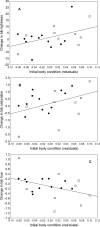Uropygial gland and bib colouration in the house sparrow
- PMID: 27280079
- PMCID: PMC4893339
- DOI: 10.7717/peerj.2102
Uropygial gland and bib colouration in the house sparrow
Abstract
Birds frequently signal different qualities by plumage colouration, mainly during mating. However, plumage colouration is determined during the moult, and therefore it would indicate the quality of individual birds during the moult, not its current quality. Recent studies, however, suggest that birds could modify plumage colouration by using cosmetic preen oil produced by the uropygial gland. In this study, I show that bib colouration is related to uropygial gland size and body condition in male house sparrows (Passer domesticus). Moreover, I conducted an experiment in which a group of sparrows were inoculated with an antigen, mimicking an illness. In control birds, short-term changes in bib colouration were related to both body condition and change in uropygial gland size. Therefore, birds that reduced uropygial gland size showed a greater colouration change. However, bib colouration did not change with the change in uropygial gland size in experimental birds inoculated with the antigen. Given that the experiment did not affect preen oil production or consumption, this finding tentatively suggests that the immune challenge provoked a change in the composition of preen oil, affecting its cosmetic properties. In short, the results of this study suggest that (1) male house sparrows produce cosmetic preen oil that alters the colouration of their bibs; (2) the more change in uropygial gland size, the more change in bib colouration; and (3) in this way, bib colouration has the potential to signal current health status, since less healthy birds showed less capacity to change bib colouration.
Keywords: Cosmetic; House sparrow; LPS; Mate choice; Passer domesticus; Sexual selection; Uropygial gland.
Conflict of interest statement
The author declares there are no competing interests.
Figures


Similar articles
-
Volume and antimicrobial activity of secretions of the uropygial gland are correlated with malaria infection in house sparrows.Parasit Vectors. 2016 Apr 25;9:232. doi: 10.1186/s13071-016-1512-7. Parasit Vectors. 2016. PMID: 27114098 Free PMC article.
-
Preen oil and bird fitness: a critical review of the evidence.Biol Rev Camb Philos Soc. 2017 Nov;92(4):2131-2143. doi: 10.1111/brv.12324. Epub 2017 Feb 23. Biol Rev Camb Philos Soc. 2017. PMID: 28231637 Review.
-
House sparrow uropygial gland secretions do not attract ornithophilic nor mammophilic mosquitoes.Med Vet Entomol. 2020 Jun;34(2):225-228. doi: 10.1111/mve.12401. Epub 2019 Aug 14. Med Vet Entomol. 2020. PMID: 31414514
-
Wax Ester Composition of Songbird Preen Oil Varies Seasonally and Differs between Sexes, Ages, and Populations.J Chem Ecol. 2019 Jan;45(1):37-45. doi: 10.1007/s10886-018-1033-2. Epub 2018 Nov 20. J Chem Ecol. 2019. PMID: 30456558
-
Female-Based Patterns and Social Function in Avian Chemical Communication.J Chem Ecol. 2021 Jan;47(1):43-62. doi: 10.1007/s10886-020-01230-1. Epub 2020 Oct 26. J Chem Ecol. 2021. PMID: 33103230 Review.
Cited by
-
Experimental study of the effect of preen oil against feather bacteria in passerine birds.Oecologia. 2020 Mar;192(3):723-733. doi: 10.1007/s00442-020-04599-8. Epub 2020 Jan 24. Oecologia. 2020. PMID: 31980936
-
Colouration of the uropygial secretion in starling nestlings: a possible role of bacteria in parent-offspring communication.Proc Biol Sci. 2024 Nov;291(2035):20241857. doi: 10.1098/rspb.2024.1857. Epub 2024 Nov 20. Proc Biol Sci. 2024. PMID: 39561795
-
Effects of genotype, sex, and feed restriction on the biochemical composition of chicken preen gland secretions and their implications for commercial poultry production.J Anim Sci. 2023 Jan 3;101:skac411. doi: 10.1093/jas/skac411. J Anim Sci. 2023. PMID: 36547363 Free PMC article.
-
The Impact of Avian Haemosporidian Infection on Feather Quality and Feather Growth Rate of Migratory Passerines.Animals (Basel). 2024 Jun 12;14(12):1772. doi: 10.3390/ani14121772. Animals (Basel). 2024. PMID: 38929391 Free PMC article.
-
Great Tit (Parus major) Uropygial Gland Microbiomes and Their Potential Defensive Roles.Front Microbiol. 2020 Jul 28;11:1735. doi: 10.3389/fmicb.2020.01735. eCollection 2020. Front Microbiol. 2020. PMID: 32849371 Free PMC article.
References
-
- Abramoff MD, Magelhaes PJ, Ram SJ. Image processing with ImageJ. Biophotonics International. 2004;11:36–42.
-
- Amat JA, Rendón MA, Garrido-Fernández J, Garrido A, Rendón-Martos M, Pérez-Gálvez A. Greater flamingos Phoenicopterus roseus use uropygial secretions as make-up. Behavioral Ecology and Sociobiology. 2011;65:665–673. doi: 10.1007/s00265-010-1068-z. - DOI
-
- Anderson TR. Biology of the ubiquitous house sparrow. From genes to populations. Oxford University Press; New York: 2006.
-
- Andersson S, Prager M. Quantifying colors. In: Hill GE, McGraw KJ, editors. Bird coloration. Harvard University Press; Cambridge: 2006. pp. 41–89. (Vol. I: mechanisms and measurements).
LinkOut - more resources
Full Text Sources
Other Literature Sources

